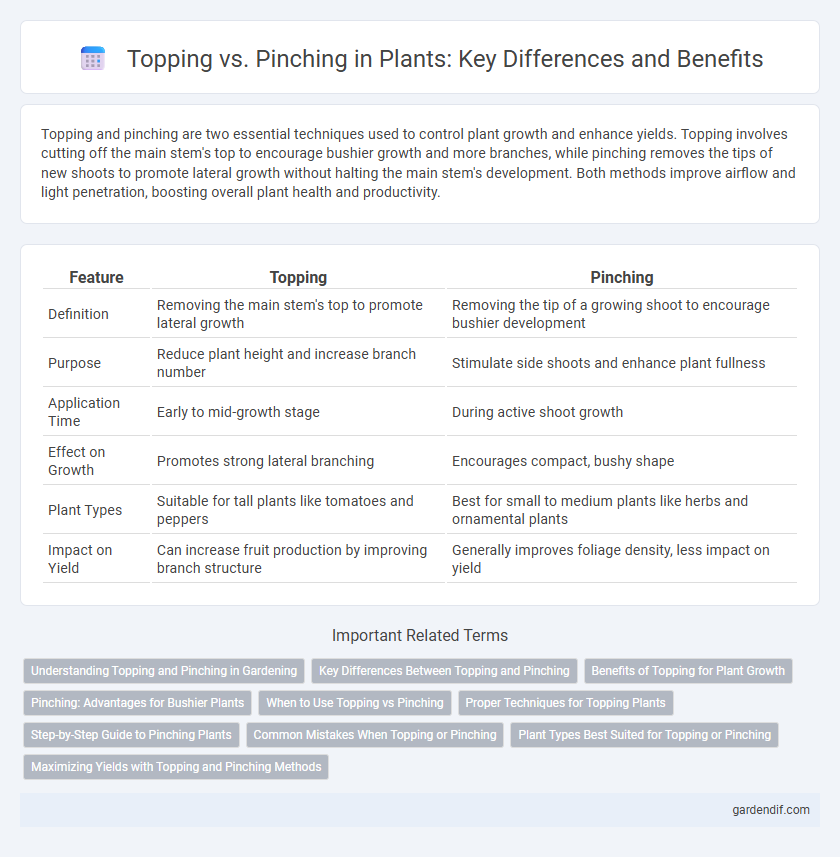
Topping vs Pinching Illustration
Topping and pinching are two essential techniques used to control plant growth and enhance yields. Topping involves cutting off the main stem's top to encourage bushier growth and more branches, while pinching removes the tips of new shoots to promote lateral growth without halting the main stem's development. Both methods improve airflow and light penetration, boosting overall plant health and productivity.
Table of Comparison
| Feature | Topping | Pinching |
|---|---|---|
| Definition | Removing the main stem's top to promote lateral growth | Removing the tip of a growing shoot to encourage bushier development |
| Purpose | Reduce plant height and increase branch number | Stimulate side shoots and enhance plant fullness |
| Application Time | Early to mid-growth stage | During active shoot growth |
| Effect on Growth | Promotes strong lateral branching | Encourages compact, bushy shape |
| Plant Types | Suitable for tall plants like tomatoes and peppers | Best for small to medium plants like herbs and ornamental plants |
| Impact on Yield | Can increase fruit production by improving branch structure | Generally improves foliage density, less impact on yield |
Understanding Topping and Pinching in Gardening
Topping involves cutting off the main stem of a plant to encourage lateral growth and create a bushier structure, which enhances light penetration and airflow. Pinching refers to removing the growing tips or buds, promoting branching and denser foliage without significantly reducing plant height. Both methods are essential horticultural techniques used to control plant shape, optimize growth, and increase yield in various garden plants.
Key Differences Between Topping and Pinching
Topping involves cutting off the main stem of a plant to encourage bushier growth and multiple colas, whereas pinching removes the growing tip or a side shoot to promote lateral branching without drastically altering the plant's height. Topping can cause more stress to plants, resulting in a temporary growth delay, while pinching is a gentler technique that allows faster recovery. Both methods improve light penetration and airflow, but topping is preferred for controlling plant height, and pinching suits delicate or smaller plants.
Benefits of Topping for Plant Growth
Topping promotes bushier growth by encouraging the development of multiple main stems, which increases the plant's overall yield potential. This technique enhances light penetration and air circulation within the plant canopy, reducing the risk of mold and pest infestations. Topped plants often exhibit stronger structural integrity, supporting heavier flowering sites and improving overall plant health.
Pinching: Advantages for Bushier Plants
Pinching promotes bushier plants by removing the apical bud, which encourages lateral growth and increases the number of branches. This technique enhances light penetration and air circulation, leading to healthier and more robust plants. Compared to topping, pinching is less invasive and helps maintain plant structure while boosting overall foliage density.
When to Use Topping vs Pinching
Use topping when you need to control plant height and encourage bushier growth by removing the main stem above a set of leaves, typically applied during the vegetative stage. Pinching is ideal for promoting lateral branching in young plants by removing the tip of a branch, which is most effective early in the plant's development before flowering begins. Selecting between topping and pinching depends on growth goals, with topping suited for reducing height and pinching for increasing fullness.
Proper Techniques for Topping Plants
Topping plants involves cutting off the main stem's top growth to promote bushier development and increased yield by encouraging lateral branching. Proper topping techniques require cutting above a node with clean, sharp tools to prevent damage and reduce the risk of infection. Unlike pinching, which removes softer new growth, topping targets mature stems, making timing and precision essential for optimal plant health and productivity.
Step-by-Step Guide to Pinching Plants
Pinching plants involves removing the growing tips using fingers to promote bushier growth and increase branching, particularly for herbs and flowering plants. Begin by identifying soft, new shoots and gently squeeze or pinch them off just above a leaf node, stimulating lateral bud development. Repeat the process regularly during the growing season to maintain plant shape and encourage a fuller, more productive plant structure.
Common Mistakes When Topping or Pinching
Common mistakes when topping or pinching plants include removing too much of the main stem or leaving excessive growth, which can stress the plant and slow development. Failing to sanitize tools before cutting increases the risk of introducing diseases or pests. Overdoing either technique too frequently can hinder flowering and reduce overall yield by disrupting the plant's natural growth cycle.
Plant Types Best Suited for Topping or Pinching
Topping is best suited for bushy plants like cannabis and tomatoes, where cutting the main stem encourages lateral growth and increases yield. Pinching works well on herbaceous plants such as basil, mint, and chrysanthemums by removing the growing tip to promote fuller, denser foliage. Understanding the plant type ensures effective application of topping or pinching to optimize growth patterns and productivity.
Maximizing Yields with Topping and Pinching Methods
Topping and pinching are essential pruning techniques used to maximize plant yields by promoting bushier growth and increased flowering sites. Topping involves cutting off the main stem's apex to encourage lateral branching, while pinching removes the tips of new growth to stimulate dense foliage development. Applying these methods strategically enhances light exposure and airflow, optimizing photosynthesis and improving overall crop production.
Topping vs Pinching Infographic

 gardendif.com
gardendif.com